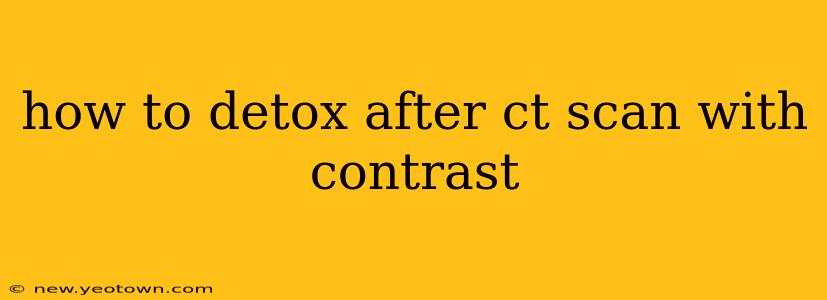How to Detox After a CT Scan with Contrast: A Comprehensive Guide
Imagine this: you've just undergone a CT scan with contrast, a vital medical procedure that provided crucial insights into your health. Now, you're likely wondering, "How can I help my body flush out the contrast dye?" It's a natural concern, and this guide will walk you through the process, addressing common questions and concerns. We'll explore the science behind contrast dye, dispel common myths, and provide practical advice to support your body's natural detoxification processes.
What Exactly is Contrast Dye and Why is Detoxification Important?
Contrast dye, usually iodine-based, is injected to enhance the visibility of organs and tissues during a CT scan. While generally safe, a small percentage of individuals may experience mild side effects like nausea or a metallic taste. The body efficiently processes and eliminates the dye through the kidneys and urinary system. "Detoxification," in this context, refers to supporting this natural elimination process to potentially minimize any discomfort and ensure the dye is cleared effectively.
H2: What are the common side effects of contrast dye?
Many individuals experience no side effects at all after a CT scan with contrast. However, some may encounter mild reactions. These can include:
- Metallic taste: This is a common, temporary side effect.
- Nausea: Some people feel nauseous after the procedure.
- Warmth or flushing: A temporary sensation of warmth spreading through the body.
- Headache: Mild headaches can occasionally occur.
Severe allergic reactions are rare but require immediate medical attention. Symptoms of a severe reaction include difficulty breathing, hives, swelling of the face or throat, and dizziness.
H2: How long does it take for contrast dye to leave the body?
The contrast dye is typically eliminated within 24 hours, primarily through urination. However, trace amounts may remain detectable for a slightly longer period. Your body's natural filtration systems are remarkably efficient at processing and removing the contrast material.
H2: What can I do to help my body eliminate the contrast dye?
While the body naturally removes the contrast dye, certain actions can support this process:
- Hydration is Key: Drinking plenty of water is crucial. Aim for increased fluid intake in the hours following the scan to help flush out the dye through your kidneys.
- Healthy Diet: A balanced diet rich in fruits, vegetables, and whole grains can support overall health and kidney function.
- Rest: Allow your body ample time to rest and recover.
- Avoid strenuous activity: Give your body a break from intense physical activity immediately after the scan.
H2: Are there specific foods or drinks I should avoid?
There are no specific foods or drinks that need to be avoided after a CT scan with contrast. Maintaining a balanced and healthy diet is generally recommended.
H2: Should I take any supplements to help with detoxification?
While some individuals may advocate for specific supplements, it's essential to consult your doctor before taking any supplements following a medical procedure. Your doctor can advise you on whether any supplements are appropriate or necessary in your case. They can also assess your overall health to ensure any supplement won't interfere with other medications or conditions.
H2: When should I contact my doctor?
Contact your doctor immediately if you experience any severe reactions, such as difficulty breathing, hives, swelling, or persistent nausea. Also, reach out if you have any concerns or unusual symptoms that persist beyond 24-48 hours.
Conclusion:
Undergoing a CT scan with contrast is a common and generally safe procedure. While the contrast dye is efficiently eliminated by the body, supporting your natural detoxification processes through hydration, a healthy diet, and rest can help ensure optimal clearance and minimize any potential discomfort. Remember, always consult your physician if you have any concerns or experience any unusual symptoms. They are the best source of personalized advice based on your individual health status.

